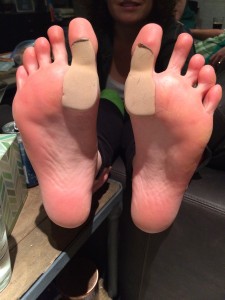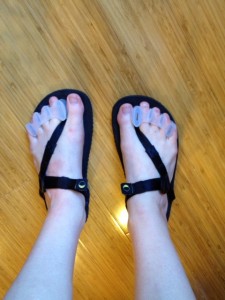11/8/2016 EDS – What is it and do I have it?
Posted by admin in My History on November 13th, 2016
EDS stands for Ehler’s Danlos Syndrome. And it’s been a recurring phrase in my family ever since my little brother got diagnosed about fifteen years ago. According to the Ehler’s Danlos Society website (http://ehlers-danlos.com/what-is-eds/), EDS is an hereditary syndrome that effects the connective tissue in the body. Although there are many types, the most common “is known or thought to alter the biology of collagen…. (the most abundant protein), which can lead to multi-systemic symptoms.” EDS has been identified as having six different types, all of which have genes associated with them – except for the hypermobile syndrome.
Why bring this up, now?
If you’ve been reading along, you’ve noticed that I go to the physical therapist at least twice per year. Also, I cannot follow a recommended training program for running (as in prepare for a marathon in 6 months! NO WAY! I’ve been trying to go farther than a 10K for four years with not so much luck or success), and I cannot train with anyone else because they inevitably progress faster than I do. After working on triathlons, running and cycling races and rides, I finally thought that I should find out if I, too, have EDS. Also, if I do have it, am I doing everything I should be doing? Or am I overdoing it by training too much?
Thus, last Tuesday, I walked into a the geneticists office for my long awaited appointment (I scheduled my November appointment in April of this year) wondering if they were going to look at me and tell me I needed to “Suck it up, Buttercup. This is normal.” Or if they would tell me there was a reason for all the PT.
Now, what happens at a genetic appointment? That’s a great question. Seeing as how I was at a research hospital at a major university who is top ranked in the nation, I had not one, but two to four people in the room at any given time. To start, two people entered the room for my initial intake, a woman with her PhD in genetics (I cannot remember if she was a post-doc, intern or full doctor because I was pretty nervous at this point) and a man who works in the lab, but wanted to see the office side of the process (he tested the DNA for the genes associated with EDS). The woman did the interviewing asking me family history (who else was flexible with soft skin, etc.) as well as my symptoms. She then had me stand up and walk, flex my knees back, flex my elbows, and touch my thumb to my wrist, which I didn’t know I could do, but was able to on my left hand – weird!
At some point, she said, “Do you have a good physical therapist?”
I almost cried.
Why? Because all of my normally developing friends have at some point or another asked or questioned why I have to go to the physical therapy so very much. And I can only reply because my Posterior Tibial Tendon is inflamed again because I did too much too fast (which means that I tried to keep up with that person’s training regimen). Or my right knee (patellular tendonitis) is inflamed. Or my right shoulder is inflamed. Or my left adductor is inflamed. You name it, it’s been inflamed due to repetitive stress injury.
So, when I walked in and the geneticist looked at me and confirmed that a PT is not only helpful but necessary, I finally felt like I wasn’t making it all up.
Flashback: When I was about 8 years old, every time my mom and I went shopping at an outlet mall or other LARGE area of concrete flooring, my feet would nearly bring me to tears because they hurt so bad. My mom did not always believe me, and sometimes I thought that maybe I was making up the pain – maybe this was what everyone felt, and they just handled it better than I did. Maybe I was just a cry baby. “Suck it up, Buttercup.”
However, in one fowl swoop, this doctor had made me realize that I had not and I am not making any of it up. It’s for real. Running for longer than three miles hurts, while run/walking for five miles is GREAT! Cycling is GREAT! As long as I have not inflamed my PTT from running too far first. Taking a six week training class to help improve run time is a disaster. Working out with a group to train for a triathlon, not always a good idea. But working out with a trainer who makes a program just for me is GREAT! Etc.
Back to the appointment, the initial geneticist and lab guy left and returned a few minutes later with Dr. Byers, the genetic guru, and another woman (genetic counselor). Dr. Byers went over an abbreviated version of the previous interview, then he examined my skin, felt for muscle tone (backs of my shoulders were a little flat – nothing some swimming wouldn’t correct), and asked me to walk. We talked about my club feet (could be indication of EDS or could have been due to my mom’s uterous being twisted), my small upper pallet (I have heard that this could be a trait, and both me and my brother had it – although he didn’t really seem to be too impressed with that trivia), and my yoga abilities.
Then, Dr. Byers said that I am definitely hypermobile, but there is no genetic test for it. He would not say that I am full on EDS, but there is definitely hyper flexibility in my joints that can lead to early onset arthritis and other difficulties as I age. He also said that my strength training was phenomenal. (Yay!) He then told me that I should swim because it is the BEST activity for joints around. In addition, he regularly swims at my neighborhood pool. Really? Great! I used to swim, but just haven’t in a while because getting back in the habit is really difficult. Blah, blah. Suck it up, Buttercup! Ready for the pool? 🙂
Now, don’t think that I am disappointed in having a non-gene specific hypermobile syndrome. Quite the opposite. By having this type, I am not in danger of having the Vascular Type, which can cause ruptures in artieries, veins and other organ tissues; nor the Arthrochalasia Type, which involves lack of muscle tone; nor do I have a type associated with gum disease and dental problems.
No, I am hypermobile. AND as far as hypermobility goes, in reality I am not THAT flexible. I will say that if you see me in a yoga class, you will likely think that I go all the time because I am basic yoga flexible. There is not a basic pose that I cannot do (except for pigeon on my right hip because that hip is tight). However, my secret is that I go to yoga on average probably one time per month. What?! How can I ALWAYS palm the floor without bending my legs, if I’m not practicing stretching everyday?
Well, turns out that if you have hypermobility, you can do that. Yay!? Now, don’t go celebrating or getting jealous at my near perfect downward facing dog. What does it mean to have hypermobile large joints?
It means that on a regular basis, I can get my large joints (knees, elbows, shoulders, ankles) off track. If this happens over and over (think walking with your kneecap moving slightly off track each step), then the muscles that are taking up the slack for the weak ligament (ligaments, in my case, are where my affected collagen are located causing the ligaments to be stretchier than is helpful) become inflamed. Another thing that happens is that if my muscles get too strong in one place and weak or not balanced in another, my poor stretchy ligaments cannot hold my joint in the correct place. This happens regularly to my shoulder joints. But more on that later.
Basically, I learned that I am not crazy. I am not making stuff up. I do not heal as fast as others, which is why I cannot follow as rigorous of a training schedule. I have to give myself time to heal between workouts, etc. So, yes, running two times per week is all I can do. Yes, strength training two times per week is great! Putting a cycling or yoga class in another day will work. AND YES, taking that extra day off if my PTT’s are hurting is fine. I’m doing it all in the right way. Listening to my body is the only way to go.
So, here’s to hypermobility. Thank you for letting me know that I’m not crazy and training slowly is okay.
Try This! A Cross Friction Rub to Help Healing 4/3/2016
While going back through my posts, I found this tip hidden in the text: a cross friction rub.
The cross friction rub is a wonderful tip that was given to me by my first Seattle Physical Therapist, Travis Orth. The cross friction rub is done by applying friction perpendicular to the tissue that is in pain for approximately 1-2 minutes. Only apply enough pressure to feel like you are applying friction across the area as the tissue will likely be tender to the touch. The purpose of the friction is to help to increase healing in a tendon/ligament, particularly one that is inflamed and has been diagnosed with tendonitis.
After the cross friction rub, it is a good idea to ice the area. When using ice on your body, you may rub a cube of ice over the area: never stop moving the ice and stop after 2 minutes or when the area becomes numb. Or take a bag of ice covered with a towel and apply it to the area for 15 min being sure to check your skin. Ice can burn your skin – especially the ice packs. Regular ice has less of a chance of burning your skin because it melts on contact, but ice packs are more likely to cause skin burns because the chemicals inside the pack do not melt. As long as you keep this in mind and move the ice or ice pack regularly, the chance of ice burn is relatively low.
In my case, I have worked on my Posterior Tibial Tendons on my right and left ankles. After a run that has left my PTTs slightly inflamed (most runs, actually), I give myself a cross friction rub because it always makes the tendons feel so much better. I do not usually ice my PTT because the ankles have less circulation and another physical therapist, Brian Crosier, recommended that I try allowing the feet and ankles to go through the normal inflammation cycle. I find that it is the same with or without ice in that area.
Note: This method does not work on all tendons/ligaments. For example, the Illiotibial Band (or IT Band) that has been diagnosed as having tendonitis, does not usually respond to the cross friction rub, although it probably won’t hurt you to try it. In addition, if you have bursitis and are trying to “work it out” by massage or cross friction rub, most likely it will only get worse as bursitis is an irritation of a bursa (a small fluid filled sack that provides cushioning around bones and ligaments). Massaging an inflamed bursa will only make it more inflamed. So, if you want to be sure you are on a ligament or tendon, check the location of the pain to look for a possible bursa (in joints of shoulder, hips, knees and elbows). This website has great illustrations: Bursitis – Mayo Clinic.
Update on Broken Toe – Day 3 April 1, 2016
Posted by admin in Reflections on April 1st, 2016
So, this is no April Fool’s joke – still have the broken toe on my right foot. 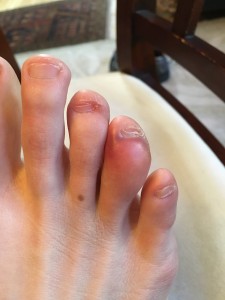 It has stopped swelling (thank goodness!) and hurts significantly less today. I am still doing my daily activities and routines, but walking is harder, especially due to the corn on my left foot, which I really scrubbed yesterday. So, my gait is a little hobbled.
It has stopped swelling (thank goodness!) and hurts significantly less today. I am still doing my daily activities and routines, but walking is harder, especially due to the corn on my left foot, which I really scrubbed yesterday. So, my gait is a little hobbled.
I am also avoiding sandals and trying to keep the toe protected inside a shoe as I can be a bit of a clutz (betcha didn’t guess that!).
As far as the corn goes, I am not going to put up a picture as I have it bandaged today (forgot to photo before getting the bandage on) and ready for adventure. It is really sore, and I will most likely use the pumice stone again in the hopes of getting to the bottom of the corn. I will be very glad when I do finally get relief from it.
Happy Friday and keep on truckin’!
So, what next? Zone 2 Training – March 30, 2016
Posted by admin in Training (running, cycling, etc.) on March 30th, 2016
I seem to have a motivation problem. I have been unmotivated to update here with the various foot items I have dealt with this past year. As seen in the May post from 2015, I had to stop running last summer. In the mean time, I strengthened my feet, stretched my calf, rode my bicycle to Canada, again, and kept on keeping on.
Now, I find myself on the cusp of another beautiful spring/summer training/racing season with two small hitches:
- A corn on the bottom of my left foot (What???)
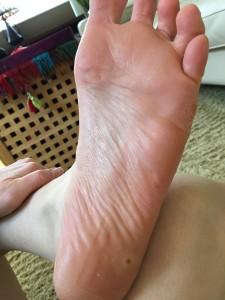
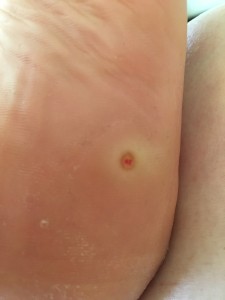 A corn, for those lucky enough to have never had one is a corn shaped (hence the name) hard callus-like formation under the skin. They usually appear on the toes, but if you are lucky enough to wear ill fitting shoes that cause friction or pressure in one spot on the bottom of your foot, you, too, may develop one of these lovely little guys. I have been trying to get rid of it by repeated use of a pumice stone on that area. So far, it has just continued to look like it does, but I have hope that one day I will get the entire corn out, which will relieve the irritation around it so that the sole of my foot can actually heal. I have since stopped wearing the shoes that I believe caused it. Here’s hoping!
A corn, for those lucky enough to have never had one is a corn shaped (hence the name) hard callus-like formation under the skin. They usually appear on the toes, but if you are lucky enough to wear ill fitting shoes that cause friction or pressure in one spot on the bottom of your foot, you, too, may develop one of these lovely little guys. I have been trying to get rid of it by repeated use of a pumice stone on that area. So far, it has just continued to look like it does, but I have hope that one day I will get the entire corn out, which will relieve the irritation around it so that the sole of my foot can actually heal. I have since stopped wearing the shoes that I believe caused it. Here’s hoping!
2. Today I broke a toe on my right foot….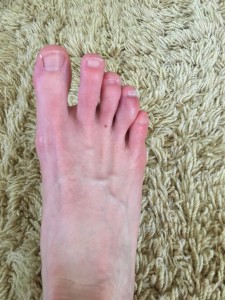
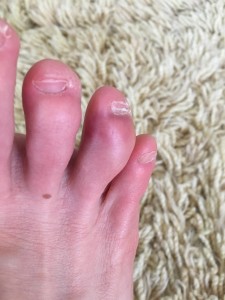 All the small inconveniences aside, I am continuing to train and walk everywhere.
All the small inconveniences aside, I am continuing to train and walk everywhere.
I have also changed my running/training philosophy from the focus-on-speed-and-always-go-as-hard-as-I-can to the train-in-Zone-2-heart-rate (using the Maffetone Method) and check-in-to-see-how-my-body-is-doing.
What is a Zone 2 heart rate? One way to find it is to take your age and subtract it from 180. That is the low end of your Zone 2. If you have an injury, or are prone to injury, take another 5 off that number for your low end. Then add 10 beats per minute for your Zone 2.
Ex: I am 39. Step 1: 180-39 = 141; Step 2 (injury prone) 141-5 = 136; Step 3 (add 10): 136 + 10 = 146 –> My Zone 2 roughly estimated is 136 to 146 heart beats per minute.
How do I execute this type of run? I wear my heart rate monitor during the workout. To start, I walk for 15 minutes to warm up my body (I try to find a good hill to hike up so that my heart rate does get an increase during the warmup). Next, I run until my heart rate hits 146 (my heart rate monitor vibrates at me to slow down as I set it up to keep me in Zone 2). Then, I walk until my heart rate hits 136 (and watch vibrates), and I repeat for the amount of time or mileage I am working toward.
I’ve been doing the Zone 2 heart rate runs since January not super regularly because of ski season. I try to only do one load bearing activity per week (i.e. a run/walk Zone 2 training or skiing each week). Since instituting this simple rule/philosophy, I have not suffered from Posterior Tibial Tendon (PTT) inflammation except for the one time that I did a run/walk two days in a row (duh!).
How has my fitness been impacted? I can now workout at least 4 times per week (one run/walk for at least an hour – working toward 1.5 hours or 6 miles – or skiing for one day; two strength training workouts; and one or two bicycle training rides) without injury! This is huge. My goal is to be injury free (whoops – broke my toe!) for this training season, and so far so good on the tendon side.
What am I hoping to accomplish? Over time, this method is supposed to help your body be more efficient and enable you to eventually run faster in a lower heart rate zone. When I run for an extended period of time, my heart rate is typically 163 to 170 beats per minute. So, my goal is to have my heart rate be in the 150’s when I run continuously (at least on flat terrain). Only time will tell for this goal.
Update on Spring 5/29/15
Posted by admin in Training (running, cycling, etc.), Try This! on March 30th, 2016
As I get ready for my grand summer of training, I figure I should reflect on what has been happening with regard to run training, bike training, and how the Whidbey Island 10K went.
So, my training for Whidbey was not super smooth, but I did get a PR! I beat my 2014 time by almost 1 minute 🙂
2014 10K results: total time 1:05:02
2015 10K results: total time 1:04:13.
I ran using the ProKinetics insoles. I had been having trouble with my Achilles tendon on my right leg and Posterior Tibial Tendons in both right and left legs on runs over 4 miles. I stopped once at 2 miles to do a cross friction rub (by the way, awesome way to trick your brain into releasing tendons or muscles!), again at 3 miles, then approximately every .5 miles until the end of the run – more frequent stops if uphills are involved. However, in the race I ran through the pain and made it the entire race without stopping, which is how I got my PR.
After the race, I have not been able to run without pain – anything over 2 miles. Did not stop me from trying to maintain a running regime
Also, side note:
I took the extra 3mm build-ups that come with the ProKinetics and put them in my bike shoes (that are clipless), and suddenly, I felt that I could actually put my big toes down in my shoes. In addition, my knee quit “wobbling” when I pedal. Kind of like magic. More on that later….
Now, I am back in physical therapy. More changes, Brian has moved onto an adventure through Ecuador – I hope he starts a blog! So, this week I worked with a new PT because the burning in my calf got to be very bad, and a massage made it very apparent that I have an inflamed soleus. Really terrified of rupturing my soleus. Nasty little muscle to heal.
Turns out that it is my insertion point for my Achilles tendon that is inflamed. So, no running. Lots of stretching and some exercises. And have to keep my head up. Hardest part. Not motivated to do the exercises because they are the eccentric motion that I have done before and not felt a lot of benefit. Bleh. Have to get going, but really sad.
Why injured? Overuse….I ramped up too fast, again. Smart training is key. More research and a plan needed. Definitely should have a plan.
Update on Training Runs 2-20-15
Posted by admin in Training (running, cycling, etc.) on May 31st, 2015
I’ve been busy working toward increasing my distance, and what I have found is that it’s going to take a while. Why? Well, the ProKinetic® Insoles changed the way that I use my feet, and the loosening of the SI joint is changing the muscles I have access to in my hips (gluteus minimus). So, I’m experiencing some interesting changes. I am going to move my race to the 10K distance and go for a PR.
I’m BAAACK! The Next Phase Plan and a Half-marathon!
Posted by admin in Appointments, Try This! on February 1st, 2015
It has been a while since that second triathlon (a.k.a. my last post). In that time, I have finished 4 sprint triathlons, one 10K and two 200 mile bicycle rides (Seattle to Portland (STP) and Ride from Seattle to Vancouver and Party (RSVP))! The reason that all of my triathlons have been sprint distance is in large part due to my run. Specifically, my Posterior Tibial Tendon (PTT) continues to give me pain in distances longer than 4 miles.
Here’s the puzzle: last year in May of 2014, I trained up to and ran a 9 mile training run, which is the longest distance I have ever completed, and I did it without pain. How? I have no idea, and it didn’t last long because quickly after that run, I upped my training with a sprint focused run group with the goal of speeding up my runs and increased mileage on the bicycle rides to accommodate the upcoming STP. Thus, I ended up in the Physical Therapists office with inflamed PTT. Needless to say, I did not complete the sprint speed training nor have I run 9 miles since.
So, why start the blog again? Because on my last visit to Brian Crosier, my Physical Therapist, he unlocked two final pieces to my puzzle, I think, and I want to document this next part of my journey.
In December 2014, I had started training up to a half-marathon, the Whidbey Island Half-Marathon on April 19, 2015, from 2 mile runs. All was great until I started running 3.5 miles and my PTT got inflamed. I also started to feel my tight right hip tighten even more. Hip tightness is a new thing that started over the summer after my STP ride with my untried new awesome carbon fiber frame bicycle, but I can tell you that story another time.
S0, I entered Brian’s office with mildly achy PTT and a fairly tight hip. As he was trying to figure out how to help me since I had already been through PTT treatment, and I was already applying the techniques he had taught me over the summer, he discovered an immobility that he had not considered treating before: my mid-foot.
So, after Brian got the foot model, much like the picture above, he began by telling me about the three arches in the foot. There is the major arch that everyone knows about, then there is an arch on the outside of your foot between your heel and your midfoot, and finally, your toe knuckles are supposed to be an arch, but most people’s are flat and not arched at all. Hmm – I’m definitely in the flat toe knuckles camp: no surprise there.
He then added that my left big toe knuckle cannot touch the ground. I laughed and told him that my left big toe knuckle touches the ground every day 🙂 He responded by using the foot model to explain that on my left foot, my main arch compensates a lot for immobility though the mid foot or the navicular bone and the cuneiform bones, meaning it flexes or “falls” in order to allow my left big toe knuckle to touch the ground because those bones do not flex enough on their own. Consequently, the Posterior Tibial Tendon attaches to the navicular bone, which means that my PTT is already being stretched out everytime I flex my arch.
Whoa! What? When Brian told me this, so many issues that I have been having my ENTIRE life began to fall into place. I have always felt like I walk on the outside of my feet, and I have these weird outer foot calluses to prove it. Also, Brian had been coaching me to land “flat” with my feet (i.e. land mid foot with by toe and outer foot touching at the same time) because I land on the outside of my feet then roll in, which puts a lot of pressure on the PTT since it is in charge of the downward/flex motion of the big arch. Well, I have been trying to land “flat” since summer 2014, and I was not feeling very successful. Guess why – I can’t. I physically cannot get that big toe on either foot (the left is worse, but the right foot suffers as well). Finally, when I ride my bicycle, even after a fancy fitting with the spacers placed to help get my knee in the correct place, I always felt that I could not get my big toes down inside the shoes. Of course NOT! I felt so much better knowing that despite my trying and failing, it was a mechanical restraint.
But with me, I’m not satisfied with just the why. I want to know the next step – how do I correct this? Of course, Brian did not disappoint! He had invented a stretch for those small, largely immobile bones of the midfoot. Â I will post a video soon with details on how to do this stretch. For now, know that after the first stretch with Brian, the tops of my feet were sore (both left and right) for two days, and the stretch is not very big. It is just that that part of my foot had never really been stretched.
Another component of the foot issue is how to get the big toes on each foot to touch the ground while still maintaining as much subtalar neutral (ankle being neutral and arch not fallen) as possible? This took convincing – Brian suggested ProKinetics® insoles that have 3mm build-up under the big toe area on each foot (see red part on the photo below). As most of you know, if you have read very much of my blog, I do NOT like inserts of any kind. After working for over a year to get out of prescription orthotics, I am not very enthused about having to use any kind of inserts again. However, Brian made a compelling point: with these inserts, my feet could possibly be placed into a better position that would allow more natural functioning with less pressure on the PTT. Hmmmmm….why does he always make such good arguments?
So, I got the ProKinetics® Insoles. They have a 3mm build-up (in red) under the big toe as well as a removeable (yell0w) arch support. In addition, they come with an extra set of 3mm build ups (orange) in case you would like a 6mm build up.
Since lots of my shoes are more minimal (Five Fingers and Luna Sandals), I also purchased a really cool adhesive lift that you stick directly to the ball of your big toes called SoleMateâ„¢ Comfort MicroLiftsâ„¢. Very cool products.
I am still in the test phase of running with full insoles, but so far the first run has been good, and I wore theSoleMateâ„¢ Comfort MicroLiftsâ„¢ with my cycling shoes today and what a difference! I know what the bike fitters have been telling me about using my whole foot – I could actually do it! My inner thighs are going to be very sore since I can access their power now, too!
The picture shows how the SoleMateâ„¢ Comfort MicroLiftsâ„¢ look and adhere to your foot. Weird, but very effective. I will say that I wore them for my trainer ride on my bicycle, and I put them back on my feet after my shower and wore them for approximately 8 more hours. Around hour six, I could tell that the skin under the adhesive was getting  a little irritated. However, when I removed it I did not have any lasting redness or raw places. The website says that these can be stuck directly to the inside of the shoes, too. So, I’m going to try that to see how it works. Definitely adding the additional 3mm orange pieces to the bicycle shoes, though!
Part two: tight hip
The why – my Sacroiliac (SI) joint on the right side, as seen in the photo below, was tight, which was impeding my ability to do some rotation and other movements, and my hip muscles, specifically the gluteus minimus, were taking up the slack and ending up overworked and tight.Â
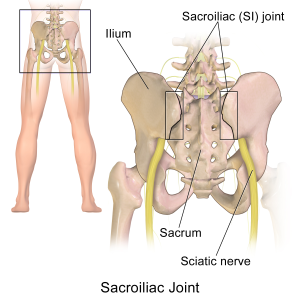 Once again, bells were going off all over the place! YES! The SI joint was tight on the right side! Of course, a few years ago I had spent an entire summer using a lacrosse ball on the right SI joint when Brian had suggested that I tuck my tail bone when I run in order to use more core muscles and attain a more efficient running form. I had not really thought much about my tail bone once it had stopped hurting, but I had never really treated it. Well, SI joint, those days are done. I am not going to neglect you anymore.
Once again, bells were going off all over the place! YES! The SI joint was tight on the right side! Of course, a few years ago I had spent an entire summer using a lacrosse ball on the right SI joint when Brian had suggested that I tuck my tail bone when I run in order to use more core muscles and attain a more efficient running form. I had not really thought much about my tail bone once it had stopped hurting, but I had never really treated it. Well, SI joint, those days are done. I am not going to neglect you anymore.
The how on treating the SI joint? To have Dr. Larry, my wonderful Chiropractor, do his magic on the SI joint when I visit him and to re-start some tennis ball massages on the SI joint. Also, I have a massage therapist, Brad, who has been working on my right hip. He will be better able to attack the problem with the new information as well. Gotta love having a village to keep it all working smoothly!
So, this is the next phase – unlock mobility in my midfoot and loosen up the SI joint on the right side. I’m still signed up for that half-marathon in April, and I’m looking forward to the training! If I can find the right combo of mechanical advantage and training pace, I may just make that race! Stay tuned!
9/29/12- Correct Toesâ„¢: An Informational Post
I have recently (as in starting Monday of this past week (9/24/12 or so)), started wearing my Correct Toesâ„¢ daily. I had a tough time with them at first: I could only comfortably wear them for approx. 1 hour, then the tops of my feet would start to ache. I would remove them, and try again in the evening. Same thing, after one hour, ache, take off.
Finally, I started trying to sleep in them. The first few nights, I would remove them at some point during my sleep. Sometimes, I found them hurled across the room. I guess my subconscious self was not so happy about these toe spreaders. After probably 5 or so nights, I would wake up with them still on! Cool!
Now, I am able to wear them almost all day (probably 8 hours comfortably in a row with my Lunaâ„¢ sandals. Then a several hour break and more wearing. I sleep in them every night, too.
Why am I doing this? Well, the Correct Toesâ„¢ were developed by a podiatrist in Portland, OR, Dr. Ray McClanahan. According to his website, “You were born with perfect feet.” And you were! 🙂 The Correct Toesâ„¢ are supposed to help undo all of the damage that modern shoe wearing does such as correct: bunions, plantar fasciosis, hammertoes and more!
Going back to the comment that you were born with perfect feet. Let’s look at baby feet to see how they look before ever meeting footwear:
 Although this picture could be better (might update it), it does show the wrinkles on the bottom of her foot really well. Now, take a minute and look at your hand….
Although this picture could be better (might update it), it does show the wrinkles on the bottom of her foot really well. Now, take a minute and look at your hand….
First, feel your palm. The skin should feel slightly different than your arm: a little leathery or tough. If you use your hands a lot, you might find rough callouses. You will see all of the lines that a palm reader uses to predict your future. Regardless of how accurate that may be, those lines show how often you bend your palm in order to make that pattern of lines. The baby’s foot has deep lines as well because she can still curl her toes and really bend her feet.
Now, look at your feet…..
Maybe feel the skin on your feet. Does it feel like your hand? Is it softer than your hand? Tougher? Does it have callouses? In looking at your feet, do you see any lines like the ones on your hand? Or is your foot somewhat line free?
If your feet have lines, good job! You have flexibility in your feet, and you probably can pick things up using your feet. Cool! No lines? Don’t worry, you can fix that. 🙂 Lines in your feet are healthy and indicate a foot that has good flexibility and is allowed to flex regularly.
Shoes with stiff soles tend to inhibit foot movement. Thus, stripping the foot of its lines.
Correct Toesâ„¢ comes into this process by helping you correctly realign your toes. See on the baby’s foot how she can splay her big toe out, and how her little toe is not even touching its neighbor? Those are “correct toes!” Her feet have not been shaped by shoes and tight toe boxes.
I am in the process of reclaiming my nonexistent baby feet. By wearing Correct Toesâ„¢, I hope to accomplish toes that don’t have to touch their neighbors as well as feet that are flexible and have good lines. I think I am well on my way.
If you are brave, post your foot pictures and tell me about your foot story! I’d love to hear it 🙂


